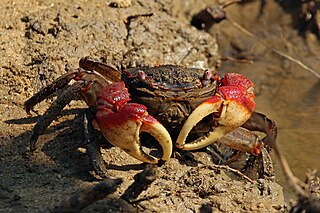
Rhizophora is a genus of tropical mangrove trees, sometimes collectively called true mangroves. The most notable species is the red mangrove but some other species and a few natural hybrids are known. Rhizophora species generally live in intertidal zones which are inundated daily by the ocean. They exhibit a number of adaptations to this environment, including pneutomatophores that elevate the plants above the water and allow them to respire oxygen even while their lower roots are submerged and a cytological molecular "pump" mechanism that allows them to remove excess salts from their cells. The generic name is derived from the Greek words ριζα (rhiza), meaning "root," and φορος (phoros), meaning "bearing," referring to the stilt-roots.

Bruguiera gymnorhiza, the large-leafed orange mangrove or oriental mangrove,) is a mangrove tree that grows usually to 7–20 metres (23–66 ft) high, but sometimes up to 35m, that belongs to the family Rhizophoraceae. It is found on the seaward side of mangrove swamps, often in the company of Rhizophora. It grows from the Western Pacific across Indian Ocean coasts to Cape Province, South Africa.

The Southern Africa mangroves are mangrove ecoregion on the Mozambique's southernmost coast and the eastern coast of South Africa.

The Sunda Shelf mangroves ecoregion, in the mangrove biome, are on the coasts of the islands of Borneo and eastern Sumatra in Malaysia and Indonesia. They are home to the proboscis monkey.

Bruguiera is a plant genus in the family Rhizophoraceae. It is a small genus of five mangrove species and three hybrids of the Indian and west Pacific Ocean region, its range extending from East Africa and Madagascar through coastal India, Sri Lanka and Southeast Asia to northern Australia, Melanesia and Polynesia. It is characterised by calyces with 8-16 lanceolate, pointed lobes, 16-32 stamens, explosive release of pollen, and viviparous propagules. It is named in honour of French explorer and biologist Jean Guillaume Bruguière (1750–1798). Recently, the eighth taxa of Bruguiera, B. × dungarra was recognised as occurring in northern Australia.

Bruguiera cylindrica is a mangrove in the family Rhizophoraceae. It grows in mangrove swamps in tropical Asia.

Parasesarma leptosoma, also known as the arboreal crab, is an arboreal, leaf-eating mangrove crab, from East and South Africa where it is found on Rhizophora mucronata and Bruguiera gymnorhiza, but not on Avicennia marina. It occupies an ecological niche similar to that of another sesarmid, Aratus pisonii, from the Americas.
Streptomyces endophyticus is a bacterium species from the genus of Streptomyces which has been isolated from roots of the plant Artemisia annua L. in Kunming in the Yunnan province in China.
Glutamicibacter endophyticus is a Gram-positive, aerobic and non-motile bacterium from the genus Glutamicibacter which has been isolated from the roots of the plant Salsola affinis in Urumqi, China.
Demequina mangrovi is a Gram-positive bacterium from the genus Demequina which has been isolated from rhizospheric soil of the mangrove plant Bruguiera gymnorhiza.
Marmoricola endophyticus is a Gram-positive, aerobic, non-spore-forming, short rod-shaped, endophytic and non-motile bacterium from the genus Marmoricola which has been isolated from the tree, Thespesia populnea, from the Beilun Estuary Mangrove Forest National Nature Reserve, China.
Brachybacterium endophyticum is a species of Gram positive, facultatively anaerobic, halotolerant, cream-pigmented bacterium. The cells are coccoid during the stationary phase, and irregular rods during the exponential phase. It was first isolated from surface-sterilized bark of Scutellaria baicalensis from Guizhou, China. The species was first proposed in 2018, and the name refers to the fact that the bacteria is likely an endophyte.
Phycicoccus is a genus of Gram positive, aerobic, non-endosporeforming bacteria. Species in this genus are mesophilic and have cells that are short rods or coccoid.
Pedococcus aerophilus is a species of Gram positive, strictly aerobic, non-endosporeforming bacterium. The species was initially isolated from air sampled in Taean County, South Korea. The species was first described in 2008, and its name is derived from Greek aer (air) and philos (loving), referring to its initial isolation from an air sample.
Pedococcus badiiscoriae is a species of Gram positive, strictly aerobic, non-endosporeforming bacterium. The species was initially isolated from a brown-coloured layer of scoria collected near a small mountain in Jeju, South Korea. The species was first described in 2013, and its name is derived from Latin badius (brown) and scoriae.
Pedococcus bigeumensis is a species of Gram positive, strictly aerobic, non-motile, non-endosporeforming bacterium. The species was initially isolated from soil on Bigeum Island, South Korea. The species was first described in 2013, and its name refers to the island from which it was first isolated.
Pedococcus cremeus is a species of Gram positive, strictly aerobic, non-motile, non-endosporeforming bacterium. The species was initially isolated from forest soil from the Changbai Mountains. The species was first described in 2011, and its name refers to the cream-colored colonies the species produces on R2A agar.
Pedococcus dokdonensis is a species of Gram positive, strictly aerobic, non-motile, non-endosporeforming bacterium. The species was initially isolated from soil from the Liancourt Rocks, South Korea. The species was first described in 2008, and its name refers to Korean name (Dokdo) for the disputed Liancourt Rocks.
Phycicoccus jejuensis is a species of Gram positive, strictly aerobic, non-motile, non-endospore-forming bacterium. The species was initially isolated from a dried seaweed sample collected from a sandy beach in Jeju Province, South Korea. The species was first described in 2006, and its name refers to the province from which it was first isolated. P. jejuensis was the first species in the genus Phycicoccus, and is the type species for the genus.

Carex baccans, the crimson-seeded sedge, is a species of flowering plant in the family Cyperaceae, with a widespread distribution in subtropical and tropical Asia; most of the Indian Subcontinent, southern China, most of Malesia, and on to New Guinea. An endophytic bacteria species, Glycomyces endophyticus, has been isolated from its roots.







